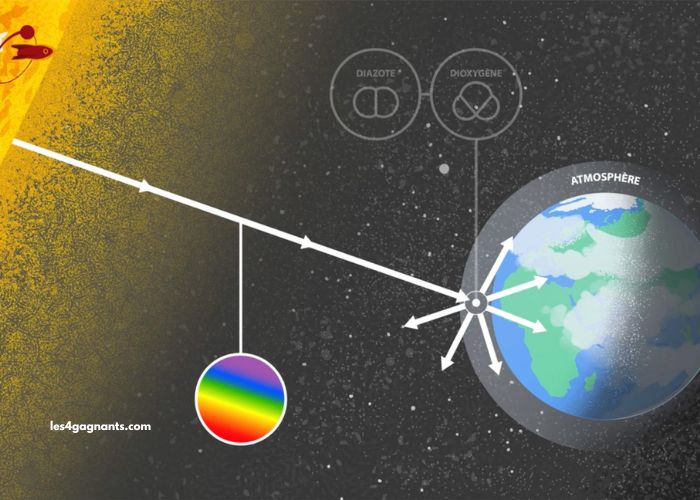The question, “Pourquoi Le Ciel Est-IL Bleu ?” is one that has puzzled many curious minds for centuries. This seemingly simple inquiry taps into the fundamental principles of physics and atmospheric science.
The blue color of the sky is a phenomenon that can be explained through a complex interaction between sunlight and the Earth’s atmosphere. By understanding the scientific principles at play, one can appreciate the subtle beauty and intricacy of this everyday occurrence.
The color of the sky is influenced by various factors, primarily the scattering of light. The concept of light scattering, first identified by the British scientist Lord Rayleigh in the 19th century, plays a crucial role in why the sky appears blue to our eyes. The wavelengths of light and their interaction with the molecules in the atmosphere are the key factors that explain this natural phenomenon.
What Causes the Sky to Be Blue?
Pourquoi Le Ciel Est-IL Bleu ? is caused by a phenomenon known as Rayleigh scattering. This occurs when the molecules in the atmosphere scatter sunlight in all directions. The sunlight appears white because it consists of a spectrum of colors, each with a different wavelength. When this white light enters the Earth’s atmosphere, shorter wavelengths of light, such as blue and violet, are scattered more effectively than longer wavelengths like red and yellow.
As a result of this scattering, blue light dominates the visible spectrum and reaches our eyes, giving the sky its characteristic blue hue. Interestingly, although violet light is scattered even more than blue, our eyes are more sensitive to blue light, which is why we perceive the sky as blue rather than violet.
The intensity of Pourquoi Le Ciel Est-IL Bleu ? can vary depending on the time of day, the position of the sun, and atmospheric conditions. For instance, during the midday hours when the sun is directly overhead, the scattering effect is at its strongest, and the sky appears a bright, vibrant blue.
How Does the Sun’s Position Affect the Color of the Sky?
The position of the sun plays a significant role in how we perceive the color of the sky. During sunrise and sunset, the sun is lower in the sky, and its light passes through a greater thickness of the Earth’s atmosphere before reaching our eyes. In these situations, the blue and violet wavelengths are scattered even more, leaving the longer wavelengths—such as red, orange, and yellow—to dominate the visible spectrum.
This explains why the sky often appears red or orange at dawn and dusk, as the scattering of shorter wavelengths is more pronounced. In the case of Pourquoi Le Ciel Est-IL Bleu ?, this process is less noticeable during the middle of the day when the sun is directly overhead. However, during these times, the sky remains blue, as the shorter wavelengths are still scattered but not to the same degree as they are during the early morning or late evening.
Atmospheric conditions also play a significant role in the appearance of the sky. For example, on days when the atmosphere contains more dust, pollution, or water vapor, the scattering of light may be altered, leading to a sky that appears hazier or even more intense in color. These factors contribute to variations in the blue hue observed in different parts of the world or at different times.
Why Is the Sky Not Purple or Green?
An interesting aspect of Pourquoi Le Ciel Est-IL Bleu ? is why we don’t perceive the sky as purple or green, even though violet and green light are scattered in the atmosphere. The answer lies in both the scattering process and the way our eyes perceive light. While violet light is scattered even more than blue light, our eyes are less sensitive to it, so we don’t perceive it as strongly.
In addition, the presence of other colors in the sunlight helps balance the effect. The combined scattering of all the colors creates a predominantly blue sky. Furthermore, the human eye is more attuned to blue and green wavelengths, making blue the most dominant color. Green, on the other hand, is largely absorbed or filtered out by the Earth’s atmosphere, reducing its visible impact.
The interaction of light with the molecules in the atmosphere is a crucial part of the explanation for Pourquoi Le Ciel Est-IL Bleu ? The shorter wavelengths of blue and violet are scattered in every direction, but the human eye’s response to these wavelengths and the mixture of other colors result in a predominantly blue sky.
How Does the Weather Impact the Color of the Sky?
Weather conditions can dramatically alter the appearance of the sky, affecting how we perceive Pourquoi Le Ciel Est-IL Bleu ? On clear days, the scattering of blue light is at its most efficient, creating a vibrant, deep blue sky. However, as weather conditions change, the color of the sky can also change.
Cloudy days often result in a sky that appears gray or white. This is because the water droplets or ice crystals in clouds scatter light in all directions, diffusing the sunlight in such a way that it no longer appears as a clear blue. The presence of rain or storms can lead to an even grayer sky, as additional particles and moisture in the atmosphere further disrupt the scattering process.
In contrast, after a storm or on clear days with low humidity, the air is cleaner, and the scattering process becomes more efficient, leading to a brighter, more vivid blue sky. Understanding the influence of weather on Pourquoi Le Ciel Est-IL Bleu ? helps explain why the sky’s color can fluctuate throughout the day or across different seasons.
Is the Blue Sky Always the Same Shade?
The shade of blue we observe in the sky is not always constant. The color can change based on several factors, such as the time of day, atmospheric conditions, and the angle at which sunlight enters the atmosphere. For example, the sky may appear pale blue during the early morning hours and darker blue during midday when the sun is high in the sky.
In addition, factors such as air pollution and geographical location can affect the intensity and shade of the blue. In areas with higher pollution or smog, the scattering effect can be reduced, leading to a less vibrant blue or even an overcast sky. Conversely, in areas with clean air and minimal pollutants, the sky tends to be a richer, more vivid blue.
Understanding the nuances of Pourquoi Le Ciel Est-IL Bleu ? allows us to appreciate the subtle changes in the sky’s color, which may go unnoticed by those who haven’t studied the factors that influence it.
Conclusion
In conclusion, the color of the sky, often explained by the phenomenon of Pourquoi Le Ciel Est-IL Bleu ?, is primarily a result of Rayleigh scattering, which causes shorter wavelengths of light, particularly blue, to dominate the visible spectrum.
The position of the sun, the presence of atmospheric particles, and weather conditions all play a role in influencing the shade and intensity of the blue sky. By understanding the scientific principles behind this natural phenomenon, we can better appreciate the beauty of the sky and its ever-changing hues.



